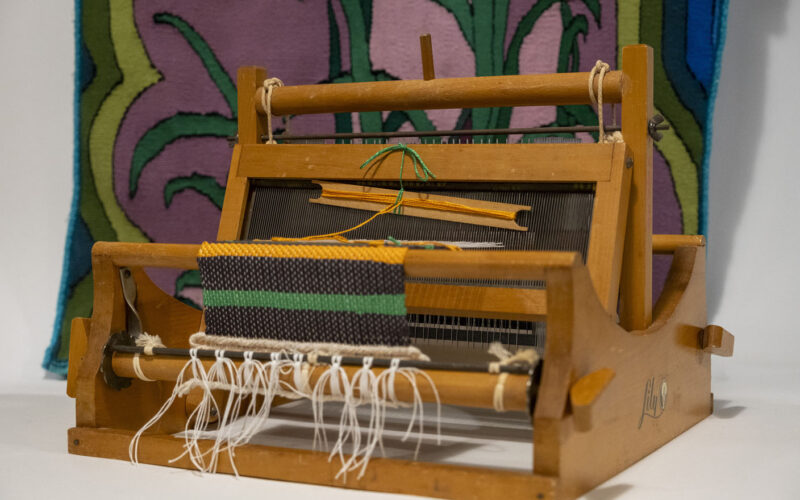BECCA MARTIN-BROWN
bmartin@nwaonline.com
To celebrate its 75th birthday, the Northwest Arkansas Handweavers Guild has collaborated with the Shiloh Museum of Ozark History for “Tracing the Threads: Weaving in the Arkansas Ozarks,” on display through Dec. 31.
“This exhibit is just special,” says Angie Albright, Shiloh Museum director. “Co-curators Carolyn Reno and Danielle Hatch have brought two centuries of weaving to life.”
Albright says highlighting Shiloh’s collection of Ozark woven coverlets alongside contemporary weaving practices “just shows that our past and present are often not so distant from each other.”
Reno, who is the museum’s assistant director and collections manager, answered these questions for The Free Weekly.
Q. How did you get interested in woven coverlets and quilts?
A. I’ve had a lifelong interest in all kinds of textiles. I’ve knitted, crocheted, embroidered, and done needlepoint. I went through a quilting phase in the 1990s, about the time I started helping to facilitate Shiloh Museum’s long-running Quilt Fair. I got interested in coverlets when Laura Redford and Marty Benson, authors of “Ozark Coverlets,” did a study of our coverlet collection in prep for writing the book. Watching them study and analyze the coverlets was an education. I really came to appreciate the skill of the weavers and the interesting patterns they wove.
Q. Historically, are coverlets and quilts from different time periods? Different geography? What were their roles in the household vs. quilts?
A. Coverlets, in a sense, preceded quilts as bedding. … Weaving in the home was a necessity for the earliest Euro-American settlers, and that was true for those who moved into the Ozarks beginning in the 1820s. They grew wool and cotton fibers on their farms. Women in the farm families processed the fibers, spun them into yarn, and wove it into goods like blankets, clothing fabric, and coverlets.
This continued until the late 1800s, when railroads came to the area bringing in affordable factory-made fabrics from the textile industry that flourished after the Civil War. By the end of the 19th century, weaving in the home was no longer a necessity. Quilts replaced coverlets and other woven bed goods when women could afford to buy or trade for fabrics to make clothes and home goods. Wasting nothing, women made scraps into quilts.
Q. Tell me about some of the treasures you got to pull out of the Shiloh closet for this exhibit?
A. Probably one of the most storied items we pulled out of collections for this exhibit is the Shuttlecraft Practical Loom that belonged to Blanche Elliott, founder of the War Eagle Fair. We were given the loom in the early 1990s. We were excited to get the loom then, but it was with this exhibit that we really discovered its connection to the enduring tradition of weaving in the Ozarks.
Blanche Elliott was the agent for Benton County Home Demonstration Clubs about 1930. She met a 19th century-trained weaver, Mary Babb, who wanted to pass weaving on to the next generation. Babb offered her loom to Elliott, if Elliott would hold lessons in her office in the Benton County Courthouse. Babb’s loom was brought to the office and the course was taught in March 1930. Women in the course went out and taught the skill to other club members. Weaving took off, especially with the developing Ozark tourist trade at the time.
In 1949 a group of local weavers formed the Northwest Arkansas Handweavers Guild. Elliott became a member, and in March 1954, the guild held a weaving study course at her home, the historic Blackburn cabin at War Eagle. They put on a public display at the end of the week. Its success inspired the guild to plan a three-day arts and crafts fair on Elliott’s property for that fall. The Ozark Arts and Crafts Fair opened in October 1954 to great success and continues today as the War Eagle Fair.
__
FAQ
‘Tracing the Threads’
WHEN — Through Dec. 31; museum hours are 10 a.m.-5 p.m. Monday-Saturday
WHERE — Shiloh Museum of Ozark History, 118 W. Johnson Ave. in Springdale
COST — Free
INFO — 750-8165 or shilohmuseum.org
FYI — The museum is open regular hours on Memorial Day.
__
Read More
Read more about the Northwest Arkansas Handweavers Guild in April Wallace’s story at https://www.nwaonline.com/news/2024/apr/21/profile-michael-skopp-as-historian-of-the-nwa/



